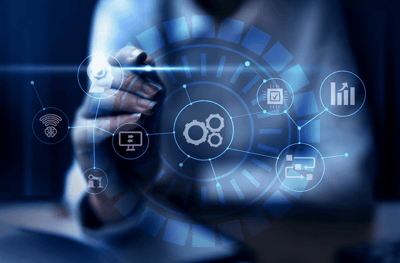AI-Powered Creativity: The Impact of Artificial Intelligence in HubSpot Design Agencies


Introduction:
Artificial Intelligence (AI) is transforming the design industry, and HubSpot design agencies are leading the way in adopting this groundbreaking technology. The integration of AI-powered creativity is revolutionizing how businesses approach design and marketing, unlocking unprecedented possibilities and driving innovation to new heights. In this blog, we will delve deeper into the profound impact of AI in HubSpot design agencies and explore how it is reshaping the entire design process.
AI-Driven Design Tools:
The implementation of AI-powered design tools has become a game-changer for HubSpot design agencies. These tools leverage advanced machine learning algorithms to analyze vast amounts of data, including user behavior, design trends, and customer preferences. The insights gained from this data allow designers to make informed decisions and identify patterns that resonate with their target audience.
One of the significant advantages of AI-driven design tools is their ability to handle complex and diverse datasets rapidly and efficiently. Traditionally, designers would have to spend a considerable amount of time conducting manual research and analysis, which could be prone to human errors and biases. AI streamlines this process, empowering designers with real-time insights that facilitate more creative and strategic design decisions.
Moreover, AI-powered design tools offer features such as image recognition and analysis. By understanding the context and significance of various design elements, such as colors, shapes, and styles, AI helps designers create more cohesive and visually appealing designs that align with the brand's identity and resonate with the target audience.
Data-Informed Design Decisions:
AI empowers HubSpot design agencies to adopt a data-driven approach to design decisions. By analyzing user engagement, interaction patterns, and historical design performance, designers gain valuable insights into what elements are most effective in engaging users and driving conversions.
Through AI-driven A/B testing and real-time user feedback analysis, design agencies can continuously iterate and optimize their designs for better results. The iterative process ensures that designs remain relevant and aligned with the evolving needs and preferences of the target audience.
AI's ability to predict user behavior and preferences based on historical data further enhances the decision-making process. This predictive capability enables designers to create designs that anticipate and meet the audience's expectations, resulting in a more seamless and user-centric design experience.
Personalization and Customization:
AI takes personalization in design to an unprecedented level. HubSpot design agencies can now create personalized content and designs tailored to individual user preferences. Through AI algorithms, dynamic content and personalized design elements adapt in real-time based on user behavior, creating a more engaging and relevant user experience.
Personalization at scale is no longer an unattainable dream. AI enables designers to cater to diverse audience segments, delivering personalized content and design variations that resonate with each user. This level of personalization strengthens brand loyalty and fosters deeper connections with the audience, ultimately driving customer satisfaction and loyalty.
AI-Generated Design Elements:
The ability to generate design elements automatically through AI has been a transformative development for design agencies. AI algorithms can now create logos, illustrations, graphics, and even custom fonts with remarkable precision and creativity. This not only saves valuable time but also empowers designers to explore more innovative and novel design possibilities.
AI-generated design elements serve as a starting point for designers, providing them with a foundation on which they can build and customize designs according to brand aesthetics and specific requirements. Additionally, AI-generated designs can be easily adjusted for different platforms and mediums, ensuring consistency and brand coherence across various marketing channels.
Creative Collaboration with AI:
AI is not replacing designers; rather, it acts as a creative collaborator. By automating repetitive tasks and providing data-driven insights, AI frees up designers' time, allowing them to focus on exploring new concepts and pushing the boundaries of creativity.
Designers can experiment with AI-generated design elements, incorporating them into their projects and infusing them with their unique artistic vision. The combination of human creativity and AI-driven insights leads to innovative and impactful design solutions that capture the essence of a brand's identity.
Furthermore, AI facilitates seamless collaboration between designers and other teams within the agency. AI-generated data and insights can be shared with marketers and developers, leading to more informed decision-making and cohesive design strategies that align with overall marketing objectives.
Continual Learning and Improvement:
AI's adaptive nature ensures that design agencies are continually learning and improving their design processes. As AI algorithms analyse more data and gather feedback from user interactions, they become more accurate in predicting design preferences and user behavior.
The learning capabilities of AI-powered design tools empower designers to stay ahead of design trends and create designs that remain relevant and effective in the rapidly evolving digital landscape. By leveraging AI-generated insights, design agencies can optimize their designs for maximum impact and ensure that their creative solutions resonate with the target audience.`
Conclusion:
The integration of AI-powered creativity in HubSpot design agencies has had a profound impact on the entire design landscape. AI-driven design tools streamline workflows, facilitate data-informed decisions, and enable personalised and customised design experiences that drive customer engagement and loyalty. :
As AI continues to advance, HubSpot design agencies must embrace its potential and leverage it to drive innovation and stay ahead of the competition. The impact of AI-powered creativity is evident in more efficient design processes, enhanced user experiences, and a brighter future for the design industry.
With AI as their ally, design agencies can unlock boundless creativity and pave the way for the next generation of cutting-edge design solutions that leave a lasting impression on businesses and their audiences. By embracing AI's potential, HubSpot design agencies can position themselves as leaders in the design space, delivering exceptional and innovative design experiences to clients across various industries.

